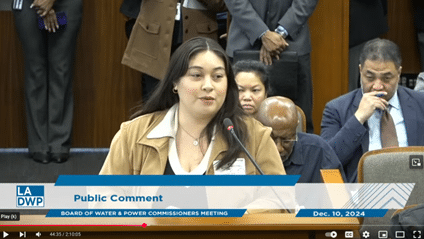
Current DWP water export:
3,590,882,743 gallons
11,020 acre-feet
2024 was once full of celebration that the Los Angeles Department of Water & Power (DWP) had committed to a new collaborative approach to restoring Mono Lake. But the optimism abruptly ended in November, when DWP quietly reversed its plan and began maximizing water exports.
DWP began taking water away from Mono Lake in October, and diversions haven’t stopped since. Export volume blew past the planned 4,500 acre-foot amount before Thanksgiving, hit 6,000 acre-feet in early December, and today the water keeps flowing through the Mono Craters tunnel.
The Committee pursued information about the unexpected export activity, making dozens of inquiries to multiple DWP staff that all went unanswered for weeks. Finally, after discussing the problem with DWP’s CEO in her Los Angeles office, pieces of information have been shared. It is now clear that DWP, despite the commitments of City leadership, has no collaborative plan in mind for Mono Lake.
DWP’s annual operations plan specified that exports would total 4,500 acre-feet of water—the same as in 2023 and 2022, and a meaningful voluntary commitment. Holding exports steady at the same level as the prior two years would help preserve recent wet year lake level gains, showing commitment to reaching the overdue, state mandated healthy level for Mono Lake, while also providing a stable level of Mono Basin water to the city. “Planned export,” DWP wrote to the State Water Board in May, “is 4,500 acre-feet.”
As DWP prepared to abandon its 4,500 acre-foot plan, it did not communicate with the State Water Board, Mono Lake Committee, or other Mono Lake parties like the California Department of Fish & Wildlife and Mono Lake Kootzaduka’a Tribe. Nor did DWP communicate its new intentions in a timely way, not even in response to dozens of inquiries from the Committee and concerned agencies.
After inquiries from Los Angeles leaders and significant pressure from the Committee, DWP water operations staff finally revealed on December 16 that DWP intends to take 16,000 acre-feet of water by March 31, 2025. This is the legal limit, and the same old maximization approach to taking Mono Basin water that has chronically impaired the lake’s ecological health and kept it well below the 6392’ Public Trust lake level.
DWP now intends to take nearly four times as much water as it took last year. And that nearly quadruples the impact on Mono Lake.

In total, DWP’s maximized water diversions will artificially lower Mono Lake a quarter foot this year. Losses like that add up, and history shows this is exactly how progress in restoring the lake is lost. Lowering the lake increases salinity, undermines the lake ecosystem, negatively impacts biodiversity and millions of migratory birds, and diminishes scenic and Tribal resources at Mono Lake.
Back in the spring, Los Angeles leadership responded positively to a call from a large coalition led by the Mono Lake Committee. The coalition asked Mayor Karen Bass to consider the low level of Mono Lake and voluntarily not increase water diversions in order to preserve recent gains and make progress toward the state-mandated, healthy 6,392-foot lake level requirement. The LA Times reported the decision as an environmental win in June, quoting Deputy Mayor Nancy Sutley saying, “Mayor Bass has been clear that building a greener Los Angeles is one of her top priorities and protecting water resources certainly falls into that.”
The group asking for action with the Committee included leaders like Mark Gold and Ed Begley, Jr., community groups like Communities for a Better Environment, East Yard Communities for Environmental Justice, and Pacoima Beautiful, alongside groups like the Sierra Club, Los Angeles Waterkeeper, and LA Audubon. Gold called the commitment “the first major environmental accomplishment for water in the Bass administration.”
Disappointment in DWP’s abandonment of the commitment runs far and wide, from Los Angeles community groups to resource agencies to the State Water Board. EPA Regional Administrator Martha Guzman, in a December large group call, called DWP’s action “surprising and discouraging.”
After DWP abandoned the 4,500 acre-foot commitment, Melanie Paola Torres, representing LA community environmental justice organization Pacoima Beautiful, spoke at the DWP Board of Commissioners public meeting, saying: “These diversions jeopardize the recovery of the lake, harm its ecosystem and worsen air quality in the surrounding region. Mono Lake is more than just a body of water. It is a living classroom and a source of inspiration. When our community visits, they see what’s at stake, they return home with a deeper understanding of environmental justice and the urgency to care for our shared resources. But if LADWP continues taking water, the lake’s recovery will stall and we risk losing this vital place forever.”
Important questions about the surprise DWP action remain unanswered. Was this DWP’s plan all along? What does Mayor Bass make of her commitment being abandoned?
The Mono water is just 1–3% of the city’s annual supply, and yet is the only water available to help Mono Lake recover from decades of excessive water diversions. The lake today is a decade late, and nine feet short of achieving the State Water Board’s mandated healthy management level.
To explain its actions, DWP has offered that, because the winter might be dry, it needs the water for the city—and, at the same time, because the winter might be wet, it has reservoir management concerns. Mono Lake’s health, notably, was not considered nor mentioned in these explanations.
Of course, DWP can manage its concerns without increasing water exports simply by operating the same way it successfully did in recent years when 4,500 acre-feet was the legal water export limit.
Regarding water supply, state reservoir storage is currently above average, and DWP’s own staff reported to the DWP Commission in October that “we now have the most water in the Southern California region than we’ve ever had in history … there’s a lot of water in storage and that is good news for us.”
DWP has also claimed the excess water exports are needed to prevent Grant Lake Reservoir in the Mono Basin from overflowing during the winter. Here, too, DWP is disregarding its own operations plan, which contains contingencies for managing the reservoir level by sending additional water to Mono Lake via Rush and Lee Vining creeks. In fact, DWP today is diverting flow from Lee Vining Creek and adding it to Grant Lake Reservoir storage at the same time it claims exports are necessary to reduce storage.
DWP water exports increase day by day, demonstrating a rejection of Mono Lake considerations and collaboration. As 2024 concludes, it is clear that 2025 will be a critical year for all of us concerned about Mono Lake’s future to speak up, take action, and make sure real action is achieved to restore Mono Lake to health.

For more information:
- DWP water export now exceeds 4,500 acre-foot commitment
- Water exports from the Mono Basin begin
- Mayor Bass’ Mono Lake diversion decision makes LA Times’ California Today front page
- Los Angeles chooses to preserve Mono Lake level gains—will not increase diversions this year
- State Water Board to hold hearing in 2025
Note: The Mono Basin export counter at the top of this post represents the total amount of surface water exported by DWP from the Mono Basin during this runoff year (April 1, 2024–March 31, 2025). We are using provisional DWP daily data to calculate the per minute rate of water export and generate the counter output. Although water export is underway around the clock at a fairly steady rate, fluctuations in the flow can affect the export total over time; if necessary, we adjust the counter accordingly.
Top photo by Maureen McGlinchy.
